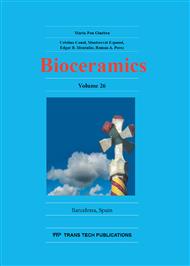p.326
p.332
p.341
p.345
p.351
p.357
p.363
p.367
p.373
Effects of Albumin Adsorption on Cell Adhesion in Hydroxyapatite Modified Surfaces
Abstract:
Synthetic hydroxyapatite (HA) is a widely used ceramic biomaterial due to its well described biocompatibility. Some modifications in HA surface can be made to increase surface porosity. Likewise, HA can be modified by the coating with proteins, which may impact on biocompatibility. In this work, we aimed to evaluate the impact of two surface modifications – coating with albumin, a major serum protein, and augmented porosity - over osteoblast adhesion on stoichiometric HA discs. Dense HA discs were obtained by pressing HA powder at 30 KN and sinterization at 1000°C, while porous HA was molded after the addition of alginate (15:1), followed by thermal treatment. Protein adsorption was attained by incubation on 0.5mg/mL bovine serum albumin (BSA) for 24 h at 37°C. MC3T3 mouse preosteoblasts were seeded over both protein-coated and uncoated dense or porous tablets, and cell viability after 24 h was estimated by XTT and Neutral Red assays. Cell density was quantified by fluorescence microscopy. While both dense and porous discs presented altered surfaces after protein treatment, as observed by scanning electron microscopy, porous HA tablets presented significantly higher levels of adsorbed protein. There was a decrease in the concentration of calcium ions in all samples analyzed. Porous HA treated with protein presented significant higher mitochondrial dehydrogenase activity (XTT) than non treated tablets (p<0.001). Although the BSA adsorption didn`t affect cell adhesion, the results obtained in fluorescence quantification suggests that de dense surface was best for cellular adhesion and spread than the porous one. We conclude that differences in the topography of a biomaterial can directly influence their ability to adsorb proteins, while the dense surface was more favorable for both the adhesion and the spreading of pre-osteoblasts.
Info:
Periodical:
Pages:
351-356
Citation:
Online since:
November 2014
Keywords:
Price:
Сopyright:
© 2015 Trans Tech Publications Ltd. All Rights Reserved
Share:
Citation:


